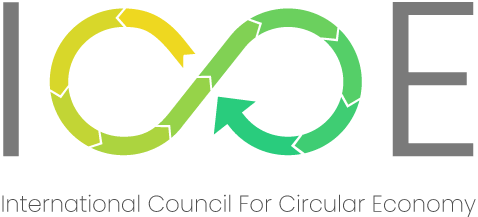I’ve worked for more than a decade in the circular economy and realised a startling fact: 500 million tonnes of construction waste is produced every year in the EU. This is enough waste to fill up the entire nation of The Netherlands. It motivated me to find greener construction methods and eco-friendly materials.
One solution is an emerging trend called 3D concrete printing (3DCP). There are several names for it, including additive manufacturing and digital fabrication. Concrete 3D Printing is achieved via layer-by-layer extrusion. This is a unique area which brings together multiple domains, such as chemists, software developers, designers, structural engineers, automation experts and most importantly creative visionaries, to formulate tomorrow’s innovations.
The circular economy also needs to be implemented in this new area. In general 3D Concrete consists of cement, aggregate, water and admixtures. In principle substituting these components with secondary raw materials will be possible eventually. However, most commercial 3D concrete do not use any industrial sidestreams but there is great potential. OPC (Ordinary Portland Cement) is the most commonly used binder, fine sand of upto 2mm size is used as aggregate.
In the 3DGREEN-CON consortium and R&D project, co-funded by the European Innovation Council (EISMEA), we have developed Finland’s first green 3D Concrete industrially. Its eco-friendly nature comes from the usage of recycled aggregate substitution.
Finland’s first green 3D Concrete
In my opinion, the use of OPC can be reduced by use of so called SCM (Substituted Cementitious Materials). At an industrial scale key secondary raw materials (industrial waste) eg blast furnace slag, silica fume and flyash can be utilised. All of these are available in large quantities especially in developing countries. Ready made cements with these by-products are also available and are found as CEM II and CEM III cements. Other SCM with stable supply can be limestone and calcined clay. Limestone derived as an industrial by-product is especially interesting for application given circularity potential.
Limestone powder has long been used as a filler component in the binder. The effect of limestone powder on rheology depends on the physical characteristics of particles, e.g., fineness and surface roughness. For improving the workability of fresh cementitious materials, an appropriate quantity of limestone powder with a similar or coarser particle size with respect to that of portland cement can be added into the mixture. Filler effect is the main phenomenon of influence on cement hydration. Replacing a minor quantity of portland cement by limestone could accelerate the early age hydration due to the increase of nucleation sites provided by the surface of the limestone particle.
Calcined clay SCM in portland cement could bring many benefits to 3DCP. Arguably, the most important factor is the abundance of accessible clay reserves. Kaolinitic clay, being technically most suitable, is rich in tropical and subtropical environments, i.e., in India and Southeast Asia]. The calcination temperature for manufacturing calcined kaolinitic clay is 700–850 °C, which is considerably lower than that of portland cement clinker production (1250–1450 °C). However, more research is needed for commercial viability.
OPC has clinker and gypsum in it. The virgin gypsum can be substituted using another industrial by-product from flugas desulphurization in power plants.
The world of alternative green cements for 3D concrete is even more exciting especially given the sustainability narrative. One of the most actively researched green cement is CSA (Calcium Aluminate Cement).
CSA has 49% lower CO2 emissions during its production compared to OPC. The CSA clinker production happens at a temperature of 1250 °C, which is 200 °C lower than OPC production. Also, CSA clinkers formed at a lower temperature are much easier to grind, resulting in further energy savings. The recent trend to produce CSA using industrial sidestreams rich in Calcite, Silica and Alumina act in favor of circular economy.
CSA gives an interesting property of rapid setting. CSA can be used as 100% substitute for OPC or partial substitute depending on the system. A combination of OPC with 7% CSA substitution has been used to create 3D concrete. This area still needs considerable research for commercial viability.
During my 7 years in green construction we investigated many of these cement systems starting from green cement production using industrial waste to different application avenues with large companies from varying industries such as UPM, Stora Enso, Fortum etc. There was varying degree of success for inconsistent raw materials.
Other alternative binders of interest are CSAB (Calcium Sulpho Aluminate Belite) and reactive MgO cements. They need significant research in 3D Concrete printing applications to ascertain their unique application potential.
Once the 3D printed object reaches end of life, there are several alternatives. It can be crushed and used as aggregate in concrete i.e entering the circular loop. Circular materials changes every aspect of construction and affects the entire life cycle of a building
Circular materials change every aspect of construction and affects the entire life cycle of a building
During my teaching sessions at a German university, I was fortunate to find out that there is enough grassroots interest in these materials, with young talent finding them an interesting area. Not only did they understand the underlying concepts of technology and sustainability that I taught, but they actively promoted them by taking things one step further and asking about the possibility of creating 3D-printed habitats using local circular materials. This is truly a step in the right direction.
3D-printed habitats using local circular materials
Given the EU Green Deal and the need to decarbonise, utilise waste and adopt a new manufacturing system we need to think in terms of the circular economy from the beginning especially for new trends like 3D Concrete. I am optimistic and feel that our joint efforts would create a society which is inclusive and sustainable.
I invite European research and technology organisations, universities, corporations, public bodies and funding organizations to collaborate and supercharge innovation, implementation and application of this new emerging industry 4.0 trend.
The post Are these the building blocks for a better future? first appeared on Innovators magazine.
